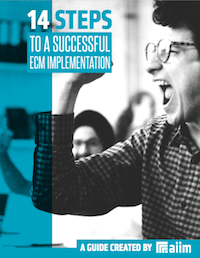The AIIM Blog
Keep your finger on the pulse of Intelligent Information Management with industry news, trends, and best practices.
I regularly get asked questions about AIIM and ARMA – which one’s “better,” which one’s the right one, what’s the difference, etc. I've been a dues paying member of both since 2001 – August 2001 for AIIM, September 2001 for ARMA. I've also served on both organizations’ Board of Directors (2004-2005 for AIIM, 2007-2010 for ARMA). I have thoughts on both and will compare them in several key areas, including: Focus Types of Membership Cost of Membership Benefits Chapters and Local Events Number of Members Before we get started, in the interest of total transparency, I serve as AIIM's VP of Training and Certification. With that in mind, our goal with this article is to be unbiased and provide those considering membership with the facts needed to make a decision.
Share
AIIM on Air | Intelligent Information Management (IIM)
The show Star Trek always had the coolest futuristic technology. For example, I can’t tell you how many times I’ve wished I could tell Scotty to “Beam me up!” and be teleported back home. Another thing that really caught my eye on that show was their “universal translator.” It was basically this handheld device that allowed you to easily communicate across any language – be it human or alien!
Share

Making an ECM implementation successful requires planning and attention to detail. The best way to create the right solution is to identify organizational goals and priorities. Learn how to manage a successful implementation in our free guide.
Digital Transformation | Paperless Office
Many of us find ourselves working from home – often rather suddenly and unexpectedly. Organizations of all sizes and in all industries are now in the position of figuring out how to ensure that the business of the business continues while staff stay home and practice effective social distancing. The good news is that the technology needed for effective working from home exists and is generally mature – though some providers have found that the sudden surge in volume can cause issues with particular solutions or capabilities.
Share
Digital Transformation | Paperless Office
For many across the globe, limiting their human contact, the home has become…well, home base for just about everything. Folks are taking advantage of virtual meeting software like GoToMeeting and Zoom to video chat with friends, host virtual dinner parties, and even play board games! And that’s just in our personal lives. In our work lives, companies are piecing together Digital Workplace strategies to allow their employees to work from home. Today, workers everywhere are booting up their laptops at kitchen tables and temporary home offices – many for the very first time. And with this change comes some new challenges like – deciding where in your home you should work from, how to deal with the new distractions, and more. Here at AIIM, remote working has been a priority of ours for many years now, and our staff has experienced it all when it comes to working from home. So, we thought we’d gather our best WFH tips for those newly remote workers.
Share
Certified Information Professional (CIP)
It's no secret that I'm passionate about training and information management. I delivered the first AIIM public training course in the U.S. in January 2006. Since then, I've delivered more than 400 workshops, seminars, breakout sessions, and training courses relating to information management – almost all in person.
Share
AIIM on Air | Accounting and Finance | Automation
I don't know about you, but when I think of Pepsi, I think of cool and refreshing. In fact, the last thing to come to mind is labor-intensive. But, for the staff at PepsiCo's Imaging Technology - the creator of document imaging and management solutions for PepsiCo’s worldwide network of business entities - labor-intensive, time-consuming, and error-prone were exactly what they were experiencing. The company's four largest European entities were still keying invoicing and credit memo data manually for all of their accounts payable processes.
Share